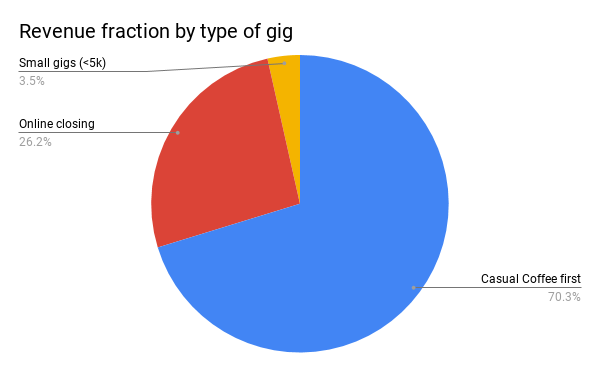Can Calendly Unbundle NYC?
How important are spontaneous coffee meetings
Venkatesh from ArtofGig is examining his own consulting practice and recently wrote this (subscribers only - but I highly recommend subscribing):
What exactly is the value of being able to take a lot of casual, serendipitous, impromptu meetings with potential clients? And how does this equation change due to the pandemic-related travel freeze, both in the short and long-term?
I won’t bury the lede: I ran the numbers for my own practice over the last 9 years, and 70.3% of my consulting revenue can be attributed to gigs that started out as casual coffee meetings, while 26.2% closed online. Here’s the pie chart (I consolidated 17 small clients with billings under 5k, and amounting to 3.5%, into one small pie slice):

So the headline is crystal clear: at least my kind of consulting practice is hugely dependent on gigs that start out as casual coffee meetings.
So I thought I’d take a look at my own stats:
How Many Clients Come from Random Coffee Meetings
This is a central piece of Venkatesh’s data - so let’s take a look at my own. This is almost 6 years of indie consulting - all %s are revenue:
I’m defining these as:
- Coffee meeting: Where the initial point of contact with the client was a somewhat unscripted coffee meeting.
- In-person: This is where the initial meeting was in-person but with more of an agenda, i.e. a meeting at the client’s office.
- Digital: This is where the whole sales funnel happened without meeting in person
- Other: These are assorted clients, mostly clients I already know where the deal happened without any kind of “sales”
So my own data differs slightly from Venkatesh. Only 17% of revenue starts as a casual coffee meeting. This number does rise to 40% if you include both casual coffees and more formal in-person meetings, though some portion of these more formal in-person meetings could happily be virtual I imagine…
Where do Clients Come From?
While we’re crunching the data let’s look at where clients from from in the first place:
I’m defining these as:
- Out of Network: A cold email, linkedin message or other inbound contact unconnected to my network
- In-network: This is working directly with someone in my network. E.g. someone I know directly reaches out to work together
- Network referral: This is where someone I know directly makes a warm intro. This is like 2nd order network referral
- Ex-client: This is where someone I’ve previously worked with reaches out at a new company
Interestingly - while out of network work is 12% of revenue this is actually only two leads (1.15% and 11.22% respectively) and this hasn’t happened since 2015. 5 years without a single cold email or contact for work. Huh.
More interestingly - is examining where the network referrals come from. Looking at who refers work to me:
40% of my consulting revenue has come from Distilled alumni.
Ok I knew this number was high but that number surprised even me. My brother’s company that I used to work at Distilled1 has been a significant source of leads. This is not referrals from Distilled - none of these leads came as “official” referrals from Distilled the agency, but rather introductions from Distilled alumni who have spread far and wide and now lead lots of fascinating work across many different agencies, consulting practices and more.
So, for me Distilled has functioned like an institution. I imagine this is the power people talk about of the kind of network you get doing an MBA etc.
Perhaps there’s something to be learned from building institutions. How might you do that? What would it look like?
Can Calendly Unbundle the Casual Coffee?
Let’s return to Venaktesh’s piece for a second. He’s analyzing these numbers to understand the link between physical location and access to consulting leads. In pre-covid times the casual coffee is the default networking tool. I’ve done lots of them (despite them not leading to a ton of work).
Casual coffees are encounters with low marginal cost around existing activity
In post-covid times what is the alternative? I’ve certainly increased the number of “casual zooms”. Can they replace casual coffees? Perhaps - especially if you use a tool like Calendly. I’ve found that using calendly I’ve managed to recreate this “low marginal cost” feeling and de-risked and de-formalized the meeting so that it’s much easier to schedule and set up a casual chat.
So let’s try an experiment. Here’s a link to my calendly. Feel free to grab some time. I’m most interested in:
- Executive sparring and finding sparring clients
- The state of media, content companies and networked writing
- Indie consulting broadly
- Self publishing and book writing / producing
But.. Take a poke around my site. If you think chatting will be good grab some time2.
Thanks
June 27, 2025
Google is Grounded and Needs to Learn How to Soar
March 21, 2025
September 3, 2024
This post was written by Tom Critchlow - blogger and independent consultant. Subscribe to join my occassional newsletter:

